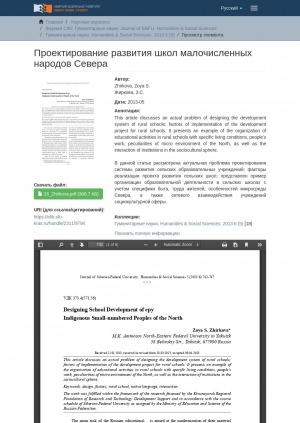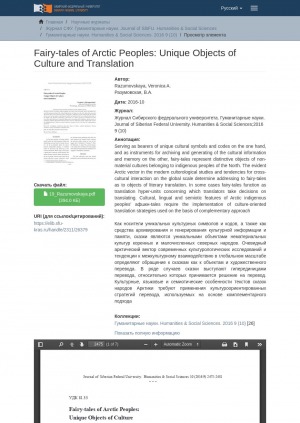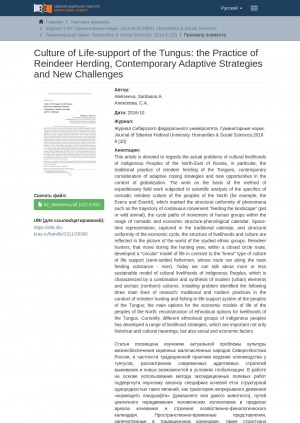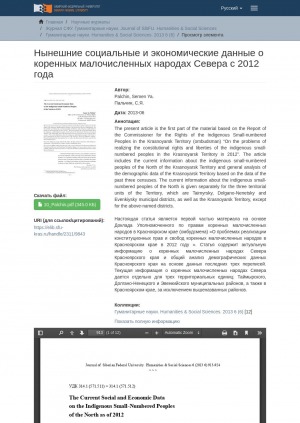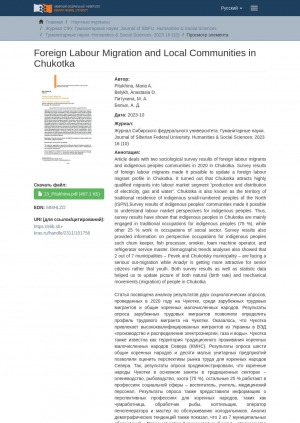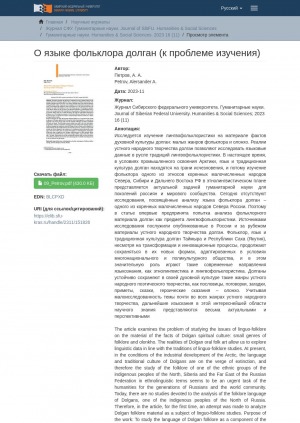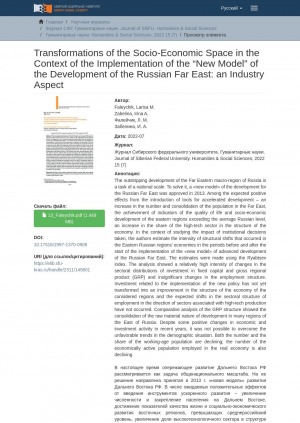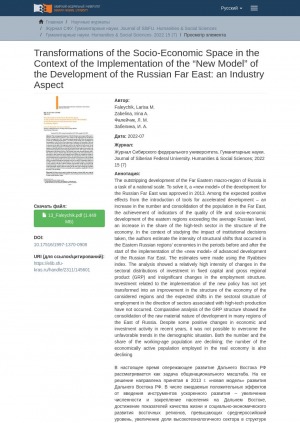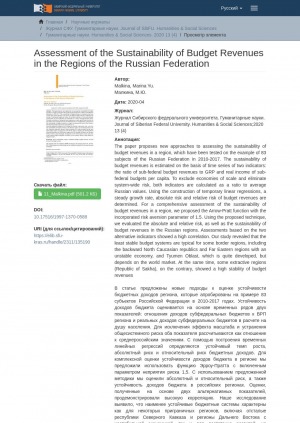-
Искусство. Архитектура. Декоративно-прикладное искусство. Фотография. Музыка. Игры. Спорт (0)
-
Медицина. Ветеринария. Техника. Транспорт. Строительство (0)
-
Общая биология. Природа. Окружающая среда. Экология. Флора и фауна (0)
-
Языкознание. Лингвистика. Художественная литература. Литературоведение (0)
- Книга (2334)
- Газета (92)
- Журнал (303)
- Автореферат диссертации (156)
- Изоиздание (1)
- Аудиоиздание (55)
- Видеоиздание (353)
- Картографическое издание (1)
- Неопубликованный документ (2)
- Нотное издание (13)
- Фотография (19)
- Статья (546)
- Библиографический указатель (99)
- Словарь (85)
- Календарь (2)
- Брошюра (49)
- Буклет (9)
- Электронное издание (2)
- Игра (1)
- 3D-модель (4)
- Грампластинка (9)
- Веб-архив (553)
- Чукотский (27)
- Долганский (11)
- Английский (82)
- Эскимоский (3)
- Эвенкийский (71)
- Эвенский (248)
- Французский (2)
- Немецкий (1)
- Хантыйский (2)
- Корякский (4)
- Мансийский (2)
- Нанайский (7)
- Ненецкий (6)
- Нганасанский (1)
- Нивхский (6)
- Старорусский (9)
- Русский (3855)
- Латинская графика (6)
- Тунгусский (9)
- Тувинский (1)
- Ульчский (1)
- Якутский (282)
- Юкагирский (51)
- Литературно-художественные издания (795)
- Официальные издания (77)
- Научные издания (1478)
- Научно-популярные издания (847)
- Информационные издания (866)
- Справочные издания (113)
- Учебные издания (429)
- Производственно-практические издания (4)
- Массово-политические издания (56)
- Изобразительное издание (23)
Год выпуска: 2013
В данной статье рассмотрена актуальная проблема проектирования системы развития сельских образовательных учреждений; факторы реализации проекта развития сельских школ; представлен пример организации образовательной деятельности в сельских школах с учетом специфики быта, труда жителей, особенностей микросреды Севера, а также сетевого взаимодействия учреждений социокультурной сферы
Год выпуска: 2016
Как носители уникальных культурных символов и кодов, а также как средства архивирования и генерирования культурной информации и памяти, сказки являются уникальными объектами нематериальных культур коренных и малочисленных северных народов. Очевидный арктический вектор современных культурологических исследований и тенденции к межкультурному взаимодействию в глобальном масштабе определяют обращение к сказкам как к объектам и художественного перевода. В ряде случаев сказки выступают гиперединицами перевода, относительно которых принимается решение на перевод. Культурные, языковые и семиотические особенности текстов сказок народов Арктики требуют применения культуроориентированных стратегий перевода, используемых на основе комплементарного подхода
Год выпуска: 2016
- Оленевод - хранитель тундры > Современное состояние оленеводства,
- Сохранение семейных традиций коренных малочисленных народов > Домашнее оленеводство в семейных традициях,
- Общественные науки. Образование,
- Краеведение. Археология. География. Биографии. История,
- КНИГАКАН > Все народы > Эвенки (тунгусо-маньчжурская группа языков) > Этнография. Фольклор.
Статья посвящена изучению актуальной проблемы культуры жизнеобеспечения коренных малочисленных народов Северо-Востока России, в частности традиционной практики ведения оленеводства у тунгусов, рассмотрению современных адаптивных стратегий выживания и новых возможностей в условиях глобализации. В работе на основе использования метода экспедиционных полевых работ подвергнута научному анализу специфика кочевой ется структурной однородностью таких явлений, как траектория непрерывного движения "кормящего ландшафта" (домашнего или дикого животного), путей цикличного передвижения человеческих коллективов в пределах ареала кочевания и строения хозяйственно-фенологического календаря. Пространственно-временные представления, запечатленные в традиционном календаре, также структурно однородны хозяйственному циклу, строению культуры жизнеобеспечения и отражены в картине мира изучаемых этносов. Оленеводы-охотники, кочевавшие в течение промыслового года по замкнутому круговому маршруту, выработали "круговую" модель жизнедеятельности в отличие от "линейного" типа культуры жизнеобеспечения (полуоседлые рыболовы, промысловые пути которых тянулись вдоль главной кормящей субстанции – реки). Сегодня можно говорить о более-менее устойчивой модели культуры жизнеобеспечения коренных малочисленных народов Севера, характерной чертой которой является комбинация и синтез элементов современной (урбанизированной) и архаичной (северной) культур. Проблемная установка определила следующие три основные исследовательские линии: традиционные и современные практики ведения оленеводства в охотничье-промысловой системе жизнеобеспечения у тунгусов, основные варианты хозяйственных моделей жизнедеятельности народов Севера и реконструкция этнолокальных вариантов жизнеобеспечения у тунгусов. Выявлено, что в настоящее время в разных этнолокальных группах коренных малочисленных народов Севера сложился целый спектр стратегий жизнеобеспечения, в котором важное значение имеют не только историко-культурные, но и социально-экономические факторы
Год выпуска: 2013
Настоящая статья является первой частью материала на основе Доклада Уполномоченного по правам коренных малочисленных народов в Красноярском крае (омбудсмена) ҺО проблемах реализации конституционных прав и свобод коренных малочисленных народов в Красноярском крае в 2012 году һ. Статья содержит актуальную информацию о коренных малочисленных народах Севера Красноярского края и общий анализ демографических данных Красноярского края на основе данных последних трех переписей. Текущая информация о коренных малочисленных народах Севера дается отдельно для трех территориальных единиц: Таймырского, Долгано-Ненецкого и Эвенкийского муниципальных районов, а также в Красноярском крае, за исключением вышеназванных районов
Год выпуска: 2023
Статья посвящена анализу результатов двух социологических опросов, проведенных в 2020 году на Чукотке, среди зарубежных трудовых мигрантов и общин коренных малочисленных народов. Результаты опроса зарубежных трудовых мигрантов позволили определить профиль трудового мигранта на Чукотке. Оказалось, что Чукотка привлекает высококвалифицированных мигрантов из Украины в ВЭД "производство и распределение электроэнергии, газа и воды".Чукотка также известна как территория традиционного проживания коренных малочисленных народов Севера (КМНС). Результаты опроса шести общин коренных народов и десяти малых унитарных предприятий позволили оценить перспективы рынка труда для коренных народов Севера. Так, результаты опроса продемонстрировали, что коренные народы Чукотки в основном заняты в традиционных секторах – оленеводство, рыбоводство, охота (75 %), остальные 25 % работают в профессиях социальной сферы – воспитатель, учитель, медицинский персонал. Результаты опроса также предоставили информацию о перспективных профессиях для коренных народов, таких как чумработница, обработчик рыбы, коптильщик, оператор пеногенератора и мастер по обслуживанию холодильников. Анализ демографических тенденций также показал, что 2 из 7 муниципальных образований – Певек и Чукотский муниципальный округ – сталкиваются с серьезным оттоком населения, в то время как Анадырь становится всё более привлекательным. И результаты опроса, и статистические данные помогли нам актуализировать картину как естественного (рождаемость), так и механического движения (миграция) населения на Чукотке
Год выпуска: 2023
Исследуется изучение лингвофольклористики на материале фактов духовной культуры долган: малых жанров фольклора и олонхо. Реалии устного народного творчества долган позволяют исследовать языковые данные в русле традиций лингвофольклористики. В настоящее время, в условиях промышленного освоения Арктики, язык и традиционная культура долган находятся на грани исчезновения, и потому изучение фольклора одного из этносов коренных малочисленных народов Севера, Сибири и Дальнего Востока РФ в этнолингвистическом плане представляется актуальной задачей гуманитарной науки для поколений россиян и мирового сообщества. Сегодня отсутствуют исследования, посвящённые анализу языка фольклора долган – одного из коренных малочисленных народов Севера России. Поэтому в статье впервые предпринята попытка анализа фольклорного материала долган как предмета лингвофольклористики. Источниками исследования послужили опубликованные в России и за рубежом материалы устного народного творчества долган.Фольклор, язык и традиционная культура долган Таймыра и Республики Саха (Якутия), несмотря на трансформации и инновационные процессы, продолжают сохраняться в их новых формах, адаптированных в условиях многонационального и поликультурного общества, и в этом значительную роль играют такие современные направления языкознания, как этнолингвистика и лингвофольклористика. Долганы устойчиво сохраняют в своей духовной культуре такие жанры устного народного поэтического творчества, как пословицы, поговорки, загадки, приметы, сказки, героические сказания – олонхо. Учитывая малоисследованность темы почти во всех жанрах устного народного творчества, дальнейшие изыскания в этой интереснейшей области научного знания представляются весьма актуальными и перспективными
Год выпуска: 2020
Одним из наиболее известных и относительно легко вычисляемых интегральных показателей устойчивости развития является показатель истинных сбережений. В настоящей статье акцент сделан на модификациях методики расчета истинных сбережений для уровня муниципальных образований на примере моногородов Сибири и Дальнего Востока. Такой выбор объекта исследования обусловлен гипотезой о том, что именно муниципалитеты испытывают большую часть экологических и социальных последствий экономического роста регионов. На основе отчетности предприятий сформирована база данных, которая затем использована для расчета истинных сбережений моногородов Сибири и Дальнего Востока. В результате получена новая классификация моногородов, включающая четыре кластера, выделенных в зависимости от уровня истинных сбережений, отрасли специализации и численности населения. Новый подход к классификации моногородов может использоваться региональными и муниципальными органами власти с целью формирования дифференцированной политики устойчивого развития моногородов. Анализ средних истинных сбережений моногородов в разрезе регионов показал, что даже если в целом регион характеризуется достаточно высокими значениями истинных сбережений, то более подробный анализ городов, в которых на самом деле находятся предприятия, обеспечивающие бóльшую часть валового внутреннего продукта страны, имеют отрицательные значения истинных сбережений и часто находятся на грани экологической или социальной катастрофы
Год выпуска: 2018
Предмет исследования – качество жизни коренных малочисленных народов севера Сибири – нганасанов и долган, локально проживающих на территории группы сельских поселений Хатангского района Таймырского (Долгано-Ненецкого) муниципального района Красноярского края. Целью настоящего исследования является анализ дифференциации субъективного восприятия качества жизни различными слоями населения, живущего в труднодоступных поселках северной арктической зоны Красноярского края. Задачей выступает применение разработанной методики сравнительного анализа качества жизни жителей в труднодоступных поселковых районах северной и центральной таежной зоны Сибири. Основной методологической базой в данном исследовании выступает группа теоретических научных методов, связанных с анализом эмпирических данных в результате анкетирования, опроса, наблюдения и интервьюирования коренного малочисленного населения в местах их проживания. Научная новизна настоящего исследования заключается в применении эффективного метода понимания и оценки качества жизни населения, компактно проживающего в суровых северных условиях и относящихся к категории коренных малочисленных народов Севера. При определении дифференциации различных слоев населения по объективной и субъективной оценке качества жизни были использованы данные статистики и выявлена степень удовлетворенности качеством образования; уровнем безопасности; деятельностью органов местного самоуправления; материальным благополучием; качеством предоставления услуг в сфере культуры; экологическим состоянием в районе и качеством медицинского обслуживания
Год выпуска: 2022
В настоящее время опережающее развитие Дальнего Востока РФ рассматривается как задача общенационального масштаба. На ее решение направлена принятая в 2013 г. "новая модель" развития Дальнего Востока РФ. В числе ожидаемых положительных эффектов от введения инструментов ускоренного развития – увеличение численности и закрепление населения на Дальнем Востоке, достижение показателей качества жизни и социально-экономического развития восточных регионов, превышающих среднероссийский уровень, увеличение доли высокотехнологичного сектора в структуре экономики. В контексте исследования влияния предпринятых институциональных решений оценивается интенсивность отраслевых структурных сдвигов, произошедших в экономиках восточных субъектов РФ в периоды до и после начала реализации "новой модели" опережающего развития Дальнего Востока РФ. Оценки выполнены с использованием индекса Рябцева. Анализ показал относительно высокую интенсивность изменений в отраслевых распределениях инвестиций и валового регионального продукта и незначительные изменения в структуре занятости. Инвестирование, связанное с реализацией новой политики, пока не привело к улучшению структуры экономики рассмотренных регионов, не произошло ожидаемых сдвигов в отраслевой структуре занятости в сторону отраслей, связанных с высокотехнологичным производством. Сравнительный анализ структуры ВРП показал, что во многих регионах Востока России отмечается закрепление сырьевого характера развития. Несмотря на отдельные позитивные изменения в экономической и инвестиционной деятельности за последние годы, неблагоприятные тренды демографической ситуации преодолеть не удалось. Сокращается как численность, так и доля трудоспособного населения; снижается и численность экономически активного населения, занятого в реальной экономике
Год выпуска: 2020
В статье предложены новые подходы к оценке устойчивости бюджетных доходов региона, которые апробированы на примере 83 субъектов Российской Федерации в 2010-2017 годах. Устойчивость доходов бюджета оценивается на основе временных рядов двух показателей: отношения доходов субфедеральных бюджетов к ВРП региона и реальных доходов субфедеральных бюджетов в расчете на душу населения. Для исключения эффекта масштаба и устранения общесистемного риска оба показателя рассчитываются как отношение к среднероссийским значениям. С помощью построения временных линейных регрессий определяются устойчивый темп роста, абсолютный риск и относительный риск бюджетных доходов. Для комплексной оценки устойчивости доходов бюджета в регионе мы предложили использовать функцию Эрроу-Пратта с включенным параметром неприятия риска 1,5. С использованием предложенной методики мы оценили абсолютный и относительный риск, а также устойчивость доходов бюджета в российских регионах. Оценки, полученные на основе двух альтернативных показателей, продемонстрировали высокую корреляцию. Наше исследование выявило, что наименее устойчивые бюджетные системы характерны как для некоторых приграничных регионов, включая отсталые республики Северного Кавказа и регионы Дальнего Востока с нестабильной экономикой, так и для достаточно развитой, но зависящей от мировой конъюнктуры Тюменской области. В то же время некоторые добывающие регионы (Республика Саха), напротив, продемонстрировали высокую устойчивость бюджетных поступлений
